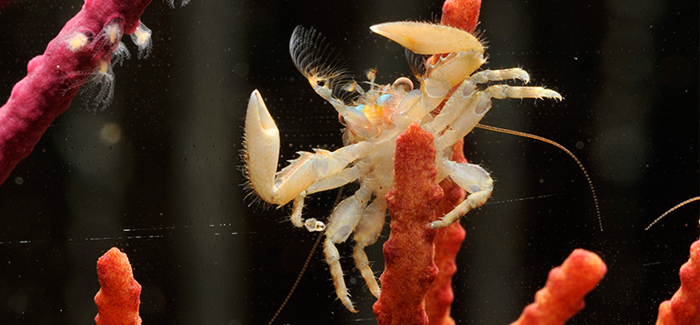
Porcelain crabs have begun showing up unexpectedly. (Photography by Michael LaBarbera)
Surprise specimens in the lab.
When you buy a shrimp from an animal supplier, you generally get a shrimp (and, occasionally, some shrimp parasites). But when you buy an oyster, you get an ecosystem: the oyster and the sponges, hydroids, barnacles, and clams growing on the oyster (the “epifauna”); the flatworms, crabs, snails, and copepods living among the epifauna; and any eggs that happen to be attached.
Some of these “volunteers” are obvious immediately, and they add a note of extra diversity to the labs. (And teachable moments. The sight of barnacles mating produces indelible memories of invertebrate debauchery.) The most obvious—and charming—volunteers this past fall were several dozen green porcelain crabs, Petrolisthes armatus, which came hidden among the clumps of oysters and barnacles.
Porcelain crabs look like flattened crabs, but are actually more closely related to squat lobsters; this species has been progressively moving north from Brazil along the coast of the Atlantic over the past 80 years and now is common in the Gulf of Mexico and along the southeast coast. Like barnacles, porcelain crabs are suspension feeders: if ambient currents are low, porcelain crabs sweep their front appendages, called maxillipeds, through the water, catching planktonic animals, but if the current is high enough, they just hold the maxilliped in the flow, like a feathery catcher’s mitt, letting the current do the work. Because currents are stronger farther from the bottom, porcelain crabs tend to be climbers; in our tanks they routinely decorated the arms of the sea fans, semaphorically flashing the yellow and blue bases of their mouthparts with messages unknown.
Some volunteers are initially cryptic but as reliable as clockwork in their appearance. For example, each time I offer Invertebrate Biology, sometime in the sixth or seventh week there appears an acoel flatworm, Heterochaerus sargassi, two to three millimeters long, a living representative of a group that immediately predates the major diversification of multicellular animals. More commonly, the volunteers are unpredictable, and every day offers the possibility of a surprise. Last quarter it came in week six when half a dozen jellyfish, two millimeters in diameter, suddenly appeared in one of the tanks, clinging to the aquarium glass like tiny ornaments. A week and several trips to the library later, I finally put a name to them: Cladonema radiatum. The jellyfish represents the sexually mature stage of a benthic hydroid (which I never found despite much searching). Cladonema is unusual in that the jellyfish stage normally lives attached to eelgrass blades, letting its tentacles stream out in the current to catch zooplankton; when disturbed, it releases its hold, swims away, and finds another spot to attach to. Apparently the glass wall of an aquarium serves as well as an eelgrass blade, giving the class—and me—a chance to appreciate the delicate symmetry of this tiny predator.
